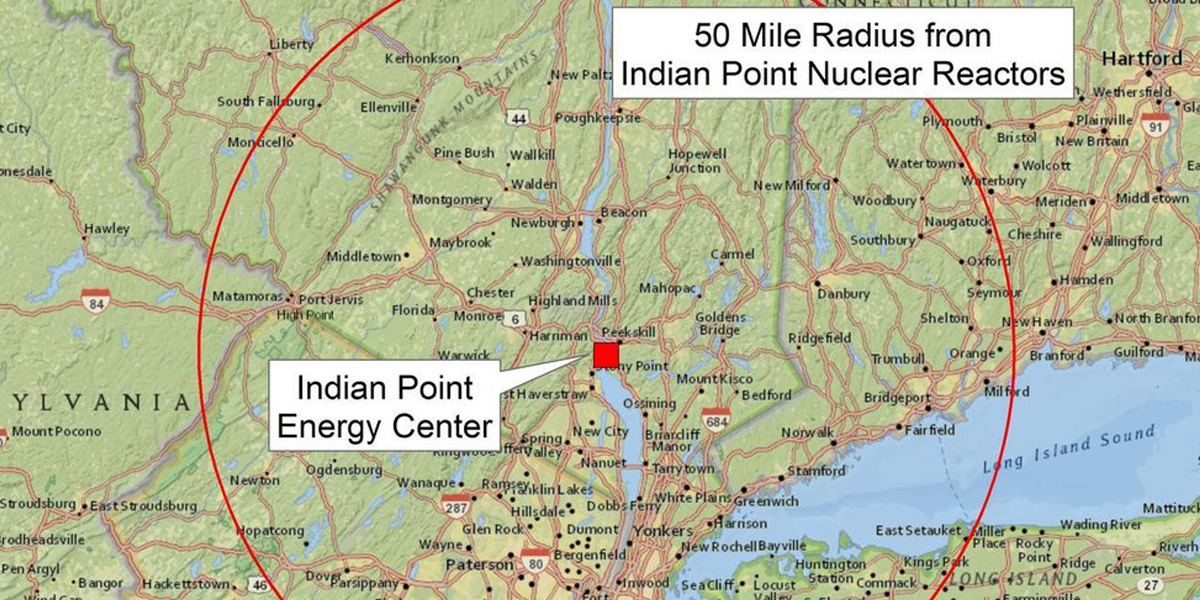

By Matthew McKinzie
New York’s Gov. Andrew Cuomo announced today that the two reactors at Indian Point Energy Center would close in the coming years, in large part due to safety concerns and the risk of a nuclear accident. The original 40-year operating licenses for the Indian Point Unit 2 and Unit 3 reactors both expired in the past three years, and today’s announcement means they are now scheduled to close in 2020 and 2021, respectively, which will reduce the risk of a nuclear accident at the facility 24 miles north of New York City.
This is especially good news for the safety of the nearly 20 million people who live within 50 miles of the two aging reactors.
“Thanks to Governor Cuomo for his tireless and tenacious efforts to close Indian Point,” Riverkeeper Vice Chairman Robert F. Kennedy, Jr. told EcoWatch.
“The agreement marks a milestone in America’s historic transition from a dirty, dangerous energy system to clean, safe, wholesome, local and patriotic power supply. It is a victory for the Hudson fishery, for public safety and for the New York economy.”
Located in such a densely-populated area, a severe nuclear accident at Indian Point would be a high consequence event. And over the years, numerous operational problems (tritium leaks, transformer fire and damaged reactor vessel bolts) and external threats (9/11, Hurricane Sandy, an underlying earthquake fault, and the construction of the nearby Algonquin natural gas pipeline) have called into question the safety of operating Indian Point.

Today’s announcement also means the electricity generation from the two reactors will be replaced with safe, renewable and truly clean energy resources like wind, solar and energy efficiency that don’t pollute the air and harm our health.
Following the Fukushima accident in Japan, the Natural Resources Defense Council (NRDC) issued a report on the potential consequences of a severe nuclear accident at Indian Point. Our analysis considered two potential accident scenarios: radiation release from Indian Point on the scale of the 2011 Fukushima accident, and radiation release from Indian Point on the scale of the 1986 Chernobyl accident. NRDC’s findings for these two scenarios are summarized as follows:
An accident at Indian Point Unit 3 on the scale of Fukushima Daiichi could require the sheltering or evacuation of as many as 5.6 million people due to a fallout plume blown south to the New York City metropolitan area. People in the path of the plume would be at risk for receiving a whole-body radiation dose greater than 1 rem, which for an average individual results in a 0.3 percent increase in risk of premature death from cancer. An accident of this scale would require the administration of stable iodine to more than six million people (where people would be at risk for receiving a thyroid radiation dose greater than 10 rad).
An accident at Indian Point Unit 3 approaching the scale of Chernobyl involving a full reactor core melt could put people in New York City at risk for receiving a whole-body radiation dose greater than 25 rem, resulting in a 7 percent increase in risk of premature death from cancer for an average individual. An accident of this scale would require the administration of stable iodine throughout the New York City metropolitan area, and put thousands at risk for radiation sickness in and near the Hudson Valley. If conditions sent the plume toward Manhattan, the island would be inhabitable due to radioactivity.
https://twitter.com/EcoWatch/status/800813757802934272
However, disconnecting Indian Point from the electric grid is only the beginning of the process of reactor decommissioning, which also includes the long-shuttered Unit 1, which was closed in 1974 due to defects in the stainless steel piping used to help keep the reactor cool.
To reach the important goal of restoring the environment in this piece of the Hudson Valley, the state must also develop a plan to safely manage the plant’s spent nuclear fuel—rods that have been stored onsite since the plant’s first unit went online in the 1960s– while the United States continues to wait for the siting of its deep geologic repository. That step must come next.
Given Indian Point’s troubled history and external threats, the decision to close the plant in the near term is the right one and will help safeguard millions of New Yorkers in the years to come.
My colleagues Kit Kennedy and Jackson Morris will be posting another blog shortly with an overview of the Indian Point closure agreement including clean energy replacement power options for New York State.
Reposted with permission from Natural Resources Defense Council.

 233k
233k  41k
41k  Subscribe
Subscribe 